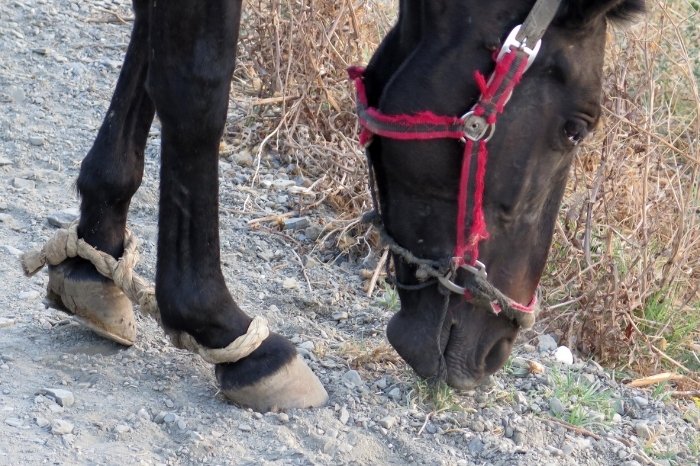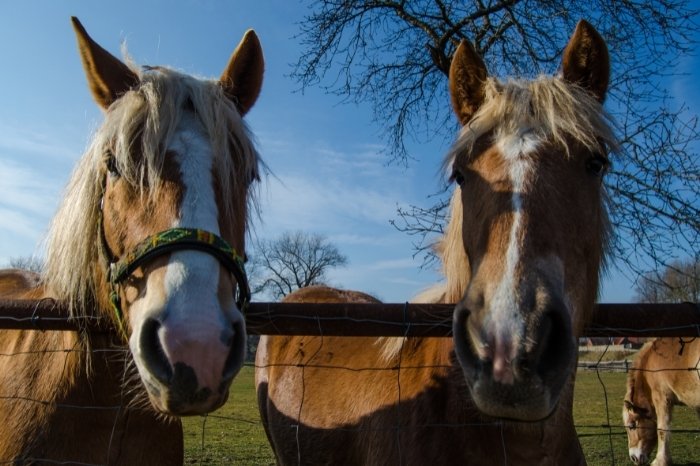Last Updated on December 24, 2021
Have you ever heard someone talk about hobbles on a horse and wonder what this means? Hobbles are a method of restraint for horses that are still commonly used in Western riding.
Nowadays, most horse owners prefer not to use hobbles on their horses. But you may still come across some situations where hobbles can be useful. Let’s find out all about using hobbles on horses!
What Does Hobbles Mean On A Horse?
Hobbles are a method of restraining a horse by using a strap or rope to loosely connect two of the legs together. The aim of hobbling is to allow the horse to still move around, but prevent them from running at high speeds. This limits the distance a horse can cover, preventing them from straying too far.
Hobbling a horse can be very dangerous if not done correctly, so it is essential that you learn all about this technique before trying it for yourself.
Today we are going to find out all about what hobbles mean on a horse and how to use them safely.

What Is A Hobble?
A hobble consists of a strap with two loops, one at each end. Each loop is fastened around one of the horse’s legs, with the strap connecting them.
The material used to hobble a horse must be carefully chosen to avoid the risk of injury to your horse. The most common materials used to hobble a horse are leather, soft rope, and nylon. Any parts of the hobble that touch the horse’s skin, such as the leg loops, should be covered in a soft material to prevent rubbing and chafing.
You should also consider how the hobbles are fastened. Leather hobbles normally have a buckle, that is easy to adjust and remove. Rope hobbles will require careful knotting to use safely, so make sure you’ve got your knotting practice up to scratch!
Check Out The 5 Best Western Saddle Makers
Why Are Horses Hobbled?
Horses are hobbled to restrict the movement of their legs. The main intention is to slow down or stop the movement of the horse, for a variety of reasons.
Hobbles can also be applied in different ways depending on the reason for hobbling.
Horses are often hobbled as a way of restraining them without tying them up. This is very common in Western riding styles, where a horse may need to stand somewhere where there is no safe place to tie it up. In this situation, the hobble strap will be quite short to stop any movement whatsoever.
Weaver Leather Horse Hobbles with Tabs
Another reason for hobbling a horse is to keep them restrained in an area where there is no fencing. This is common practice on long trail rides where the riders camp out overnight. Loose hobbles allow the horse to wander slowly and graze, without moving too far away from camp.
The final reason that horses might be hobbled is when a mare is being covered, or mated, by a stallion. Mares sometimes kick out with their hind legs towards the stallion during this process and may injure the stallion. Hobbles are applied to prevent the mare from kicking.
Read more about Types Of English Spurs
Is It Safe To Hobble A Horse?
If the horse is fully trained and the hobbles are used correctly, then it is perfectly safe to hobble a horse. Tying a horse’s legs together might sound like a harsh technique to use, but it does have many advantages.
Hobbles are used as a training tool to help the horse become accustomed to having objects around and attached to his legs. The use of hobbles can desensitize him to the feeling of a rope around his legs, reducing the risk of him panicking if he gets a leg trapped in the future. Hobbling can also teach him to be patient and to be more aware of where his legs are being placed.
However, if not done correctly, hobbling can be very dangerous. If the horse is not accustomed to objects around his legs he may panic and try to run, resulting in serious injury. He may fall over, or even fracture a limb.
If the horse does not accept the hobbles and continuously tries to pull against them, the hobbles will rub and cause injuries to the skin. The skin and hair on a horse’s legs are very thin, and any rubs will take a long time to heal.

How To Hobble A Horse Safely
If you are planning on hobbling your horse, you will need to undergo a slow and careful training process first:
-
Desensitize Your Horse’s Legs
Make sure your horse is completely comfortable with having his legs and feet handled. Use objects such as ropes, cloth, brushes, and leather straps to rub the legs. You need to get to the point where the horse does not react at all when touched.
-
Desensitize Your Horse To Pressure
This step helps your horse learn not to panic and pull away when the hobbles tighten. Loop a soft rope around the leg and pull gently – when the horse lifts his hoof or moves his leg release the pressure.
-
Apply Hobbles Without Connecting Them
Pop a hobble on one leg, and hold the other end. When the horse tries to move, apply gentle pressure on the hobble. As soon as he stops trying to move, release the pressure.
-
Connect The Hobbles
Starting with just a few minutes at a time, connect the hobbles together. He may try to move at first, so calm him with your voice and allow him to come to a halt by himself. If the previous steps have all been implemented he should quickly learn to stand still when hobbled.
Summary
So, as we have learned, hobbles are used to restrict the movement of a horse’s legs. This can be to stop them from moving altogether or to slow them down. A horse must be carefully trained to accept the use of hobbles, otherwise, he may panic and injure himself.
We’d love to hear about your experiences with hobbled horses. Is your horse trained to use hobbles and accepts them quite happily? Or maybe you have some questions about how to use hobbles on your horse? Add a comment below and we’ll get back to you!

Kate Chalmers is a qualified veterinary nurse who has specialized in horse care for the vast majority of her career. She has been around horses since she was a child, starting out riding ponies and helping out at the local stables before going on to college to study Horse Care & Management. She has backed and trained many horses during her lifetime and competed in various equestrian sports at different levels.
After Kate qualified as a veterinary nurse, she provided nursing care to the patients of a large equine veterinary hospital for many years. She then went on to teach horse care and veterinary nursing at one of the top colleges in the country. This has led to an in-depth knowledge of the care needs of horses and their various medical ailments, as well as a life-long passion for educating horse owners on how to provide the best possible care for their four-legged friends.
Kate Chalmers BSc (Hons) CVN, Dip AVN (Equine) Dip HE CVN EVN VN A1 PGCE

